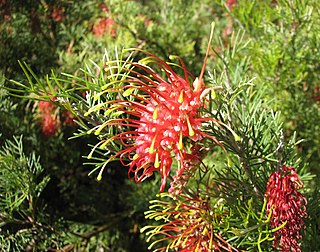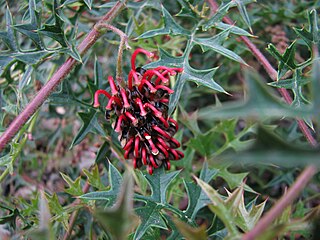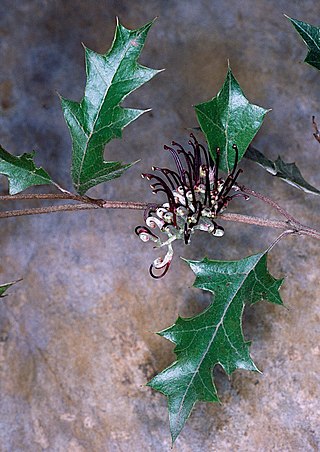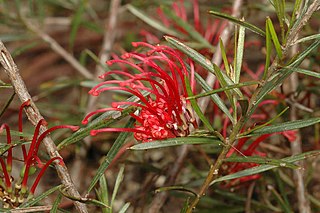
Grevillea thelemanniana, commonly known as spider net grevillea, is species of flowering plant in the family Proteaceae and is endemic to Perth, Western Australia. It is a spreading shrub with linear and pinnatipartite to pinnatisect leaves with linear to narrowly elliptic lobes, and clusters of 6 to 14 pinkish-red and cream-coloured flowers with a red, green-tipped style.

Grevillea vestita is a species of flowering plant in the family Proteaceae and is endemic to the southwest of Western Australia. It is an erect, spreading, prickly shrub with lobed leaves, the number and arrangement of lobes depending on subspecies, and more or less spherical to dome-shaped clusters of hairy, white to cream-coloured flowers sometimes tinged with pink.

Grevillea sericea, commonly known as the pink spider flower, is a species of flowering plant in the family Proteaceae and is endemic to New South Wales. It is a shrub with elliptic to lance-shaped leaves with the narrower end towards the base, and clusters of usually pink flowers arranged on one side of a flowering rachis.

Grevillea obtecta, commonly known as Fryerstown grevillea, Elphinstone grevillea or Taradale grevillea, is a species of flowering plant in the family Proteaceae and is endemic to Victoria in Australia. It is a prostrate, clumping or straggling shrub with pinnatifid, pinnatipartite or toothed leaves, and toothbrush-like clusters of light green to yellowish and purplish to black flowers with a dull yellow to pink style.

Grevillea umbellulata is species of flowering plant in the family Proteaceae and is endemic to the south-west of Western Australia. It is a spreading shrub that forms a lignotuber, has linear to narrowly elliptic leaves, and cylindrical clusters of hairy, white to cream-coloured flowers often tinged with grey or pink.

Grevillea hilliana, commonly known as white silky oak, white yiel yiel, Hill's silky oak and grey oak, is a species of flowering plant in the family Proteaceae and is endemic to eastern Australia. It is a tree with lance-shaped to oblong or lobed adult leaves and cylindrical clusters of large numbers of white to pale green flowers.

Grevillea glossadenia is a species of flowering plant in the family Proteaceae and is endemic to Queensland, in northeastern Australia. It is an erect shrub with more or less elliptic leaves and deep yellow-orange to orange-red flowers.

Grevillea montis-cole, commonly known as Mount Cole grevillea, is a species of flowering plant in the family Proteaceae and is endemic to central-western Victoria, Australia. It is a shrub with divided leaves with 5 to 15 lobes, the end lobes more or less triangular to narrowly oblong and sharply-pointed, and clusters of greenish to fawn and dull purplish flowers.

Grevillea diversifolia, the variable-leaved grevillea, is a species of flowering plant in the family Proteaceae and is endemic to the south-west of Western Australia. It is an erect to prostrate shrub with simple or divided leaves and groups white to cream-coloured flowers with a dull red style.

Grevillea jephcottii, commonly known as Pine Mountain grevillea, green grevillea or Jephcotts grevillea is a species of flowering plant in the family Proteaceae and is endemic to a restricted area of Victoria. It is a low dense, to tall spindly shrub with narrowly oblong to narrowly elliptic leaves, and clusters of pale lemon or greenish flowers with a purplish style.
Grevillea hockingsii is a species of flowering plant in the family Proteaceae and is endemic to south-eastern Queensland. It is an erect shrub with oblong to narrowly elliptic leaves and clusters of reddish-pink flowers.
Grevillea cyranostigma, commonly known as Carnarvon grevillea or green grevillea, is a species of flowering plant in the family Proteaceae and is endemic to the Carnarvon Range and adjacent areas of central Queensland. It is a spreading shrub with woolly-hairy to silky-hairy branchlets, narrowly oblong leaves, and pale green flowers.

Grevillea scortechinii, commonly known as black grevillea, is a species of flowering plant in the family Proteaceae and is endemic to eastern Australia. It is a prostrate to sprawling shrub with serrated to pinnatifid leaves, the end lobes broadly triangular and often sharply-pointed, and clusters of brown flowers with a dark purplish-black style. There are two subspecies, subsp. scortechinii found in Queensland and subsp. sarmentosa, found in New South Wales.

Grevillea sessilis is a species of flowering plant in the family Proteaceae and is endemic to north-eastern Queensland. It is a shrub or small tree with divided leaves and cylindrical clusters of white flowers with a creamy-white or greenish yellow style.

Grevillea molyneuxii, commonly known as Wingello grevillea, is a species of flowering plant in the family Proteaceae and is endemic to a restricted area of south-eastern New South Wales. It is a spreading shrub with narrowly oblong or narrowly elliptic to linear leaves and cylindrical clusters of reddish flowers.

Grevillea refracta, commonly known as silver-leaf grevillea, is a species of plant in the protea family and is native to northern Australia. It is a tree or shrub usually with pinnatipartite leaves and red and yellow flowers arranged on a branched, downcurved raceme.

Grevillea quadricauda, commonly known as four-tailed grevillea, is a species of flowering plant in the family Proteaceae and is endemic to eastern Australia. It is an erect, dense, bushy shrub with narrowly egg-shaped to elliptic leaves and small, loose clusters of green and pinkish-red flowers.

Grevillea dryandri is a species of flowering plant in the family Proteaceae and is endemic to northern Australia. It is a spreading to erect shrub with divided leaves with up to seventy or more linear to narrowly elliptic leaves, and long clusters of red, orange-red, pink or white flowers.
Grevillea cravenii is a species of flowering plant in the family Proteaceae and is endemic to a small area along the north west coast of the Kimberley region of Western Australia. It is a spreading to weakly erect shrub with narrowly oblong leaves with lobed or toothed edges, and purplish-red to dark maroon flowers.

Grevillea goodii, also known as Good's grevillea, is a species of flowering plant in the family Proteaceae and is endemic to the Northern Territory. It is a prostrate shrub with egg-shaped to narrowly elliptic leaves and clusters of light green flowers with a pink to red style.


















